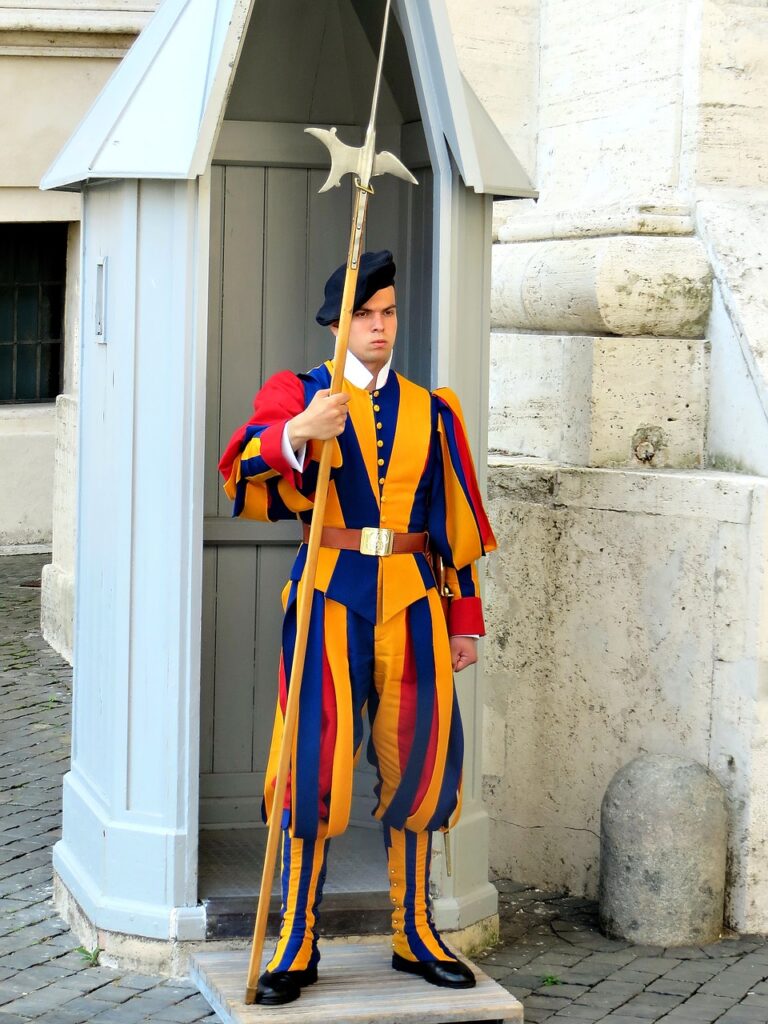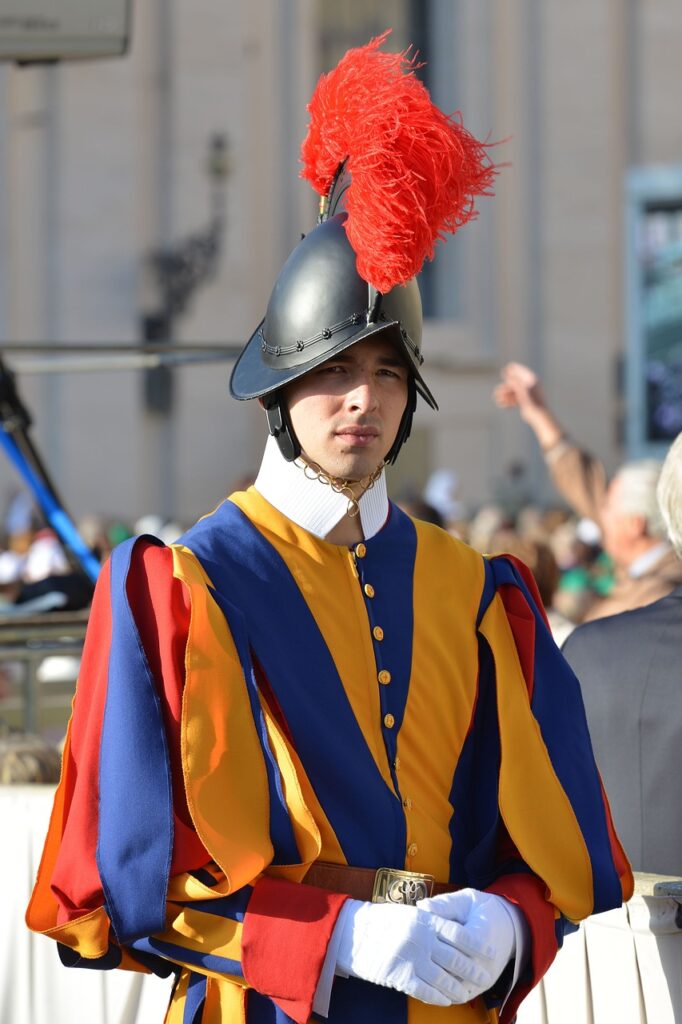
Vatican city-state considered to be the smallest country in the world. Vatican City contains religious and cultural sites like the famous St Peter’s Basilica, the Sistine Chapel, and the Vatican museums. This city-state features the world’s famous artworks like paintings and sculptures. In addition, tourism and donations contributed a significant portion of the Vatican’s economy.
In terms of diplomacy, the Vatican is a neutral country. They did not involve in any conflicts since 1929. However, the Vatican still possesses a small portion of a fighting force called the Swiss Guard, widely known as the Pontifical Swiss guard. With only 135 men, the Pontifical Swiss Guards helped protect the pope and all properties within the Vatican’s territory.
Who are the Swiss Guards
From its unit name, people will be guessing that this military unit consists of a bunch of Swiss army men. A lot of Swiss armies have served various European Countries since the 15th century, where most of them serve as guards in the imperial court. During the 1800s, the Swiss Federal Constitution forbid Swiss men from providing military service to other nations. However, a special exception was allowed for those serving the pope in Vatican city. Later, this group was widely known as the Pontifical Swiss Guard or Guardia Svizzera Pontificia.

The Origin of The Pontifical Swiss Guard
In 1506, Pope Julian II raised his own army regiment consisting of 150 Swiss mercenaries to make up the force. Pope Julian II took this action to protect his authority as the new leader of the catholic church. Since that year, the guard served the Vatican to these days. The Pontifical Swiss Guard is considered by many as one of the world’s longest-serving military units that are still active.

To be a Pontifical Swiss guard, some of the requirements below need to be met:
- Only open to catholic males of a Swiss origin
- Completed military training with the Swiss military
- Height must be at least 176.6 cm
- Be between the ages of 19 to 30 years old
If accepted, the newly recruited Swiss guard will attend a ceremonial vow, which requires them to make a vow to protect the pope and the city. Their promise contains a vow to protect the pope and sacrifice their life if necessary to defend them.
What are the roles of the Pontifical Swiss Guard?
Back in their early establishment, the main responsibilities of the Guards are to protect the pope at all costs and maintain public order in the Vatican. In 1970, the guard serves mainly for ceremonial functions and purposes. Pope Paul VI also relied more on the help of the Gendarmerie corps to defend Vatican city and to maintain public order.


However, after the assassination attempt on John Paul II on 13 May 1981, the role of the Swiss Guard was once again shifted. The Vatican developed the Swiss Guard into a modern corp of guards. From only relying on their halberds and old bolt-action rifles, they received new modern weapons like Glock pistols, SIG assault rifles, and SIG submachine guns.
In addition, they have 2 uniforms depending on their daily tasks. During ceremonial purposes, the Guards will wear the famous combination of red, blue, and yellow uniforms. The guard has worn this uniform since 1910 and it remains unchanged. However, when guarding the pope in public places, the guard will change their uniform to plain clothes or even a suit. To conclude, the role of the Swiss guard is very important to this day. This unit considered to be the iconic part of the Vatican city.
Swiss Guard During Conflicts
One may think that the Pontifical Swiss Guards never really witness any battle throughout their years of service since 1506. But, during their early years of existence, the Swiss Guard experienced a battle that make their fierce reputation heard around the world and their bravery recorded in history.
Sack of Rome (1527)
On the morning of May 6, 1527, a group of army consisting of 20,000 mercenaries arrived at the outskirts of Rome under the banner of the Holy Roman empire. The growing power of Charles V of the Holy Roman Empire alerted Pope Clement VII. The pope perceived that emperor Charles was attempting to invade Italy and dominate the catholic church. To ward off this threat, the Vatican city formed an alliance with Charles V’s enemy, known as King Francis I of France.
The army of the Holy Roman Empire defeated the French army in Italy. However, the Emperor did not have the fund to give to his army. Later on, this group of army decided to do a mutiny and force their commander Charles De Bourbon to lead them to Rome. The reason for choosing Rome as their target for pillaging was caused by the internal political conflict at the Vatican court. In addition, people considered the city of Rome to be lacking manpower to defend the city.
The last stand of the guards
The mutinied soldiers chose the right target this time. Only by 7.30 am, the invading army successfully penetrate through Rome’s defenses and reached the Vatican district. During this battle, Rome relied only on its citizens and armed militia to ward off the attackers, which considered being a desperate defense. However, the invading army stopped on the steps of St. Peter’s Basilica. 189 Swiss Guards stood their ground warding the mercenaries with their halberds, pikes, and swords.
These guards knew that their actions will be useless. Especially in facing an opponent that amounts 100 times more than them, they realized that destruction was certain. But, the guards stick with their vow to the end and show unwavering courage. At the end of the day, the invading army successfully pillaged the city of Rome. From various accounts and witnesses, they mentioned those holy relics were stolen and thousand of Roman citizens were cruelly tortured. Even holy places like churches and monasteries could not escape the wrath of the blood-thirst mercenaries.
Despite the destruction in the city, the sacrifice made by the guard was able to save the pope. Their last stand allowed the pope and his ancillaries to escape through the tunnel and reach Castle Sant’Angelo. The incredible tale of bravery displayed by the Swiss Guard lives on this day. To this day, new recruits of the Swiss Guard sworn on the anniversary of the courageous last stand took place. In addition to the new recruit ceremony, the Swiss Guards will also hold a mass to pray and remember the courage of their predecessors.
The new recruits ceremony will require each individual to grasp the Pontifical Swiss Guard’s banner with their left hand. While grasping this banner, they will be raising their right hand and reading the oath in their native language (French, German or English). Their oath contains:
“I, (name), swear to diligently and faithfully abide by all that has just been read out to me, so help me God and his Saints.“
Further Read
https://www.thisiswhywestand.net/single-post/2018/02/07/the-stand-of-the-swiss-guard
https://www.whatalifetours.com/the-top-7-most-important-swiss-guard-facts/

One thought on “Swiss Guard: Role Of The World’s Smallest Army”